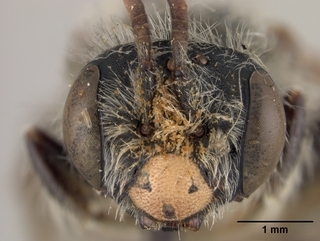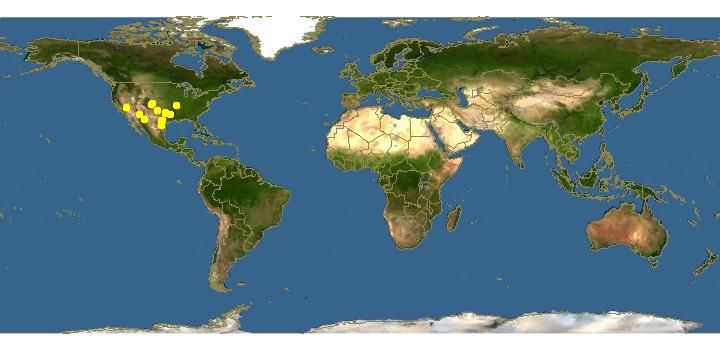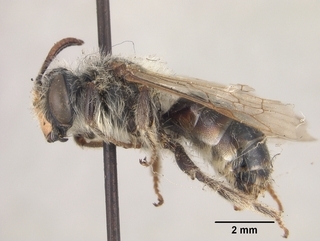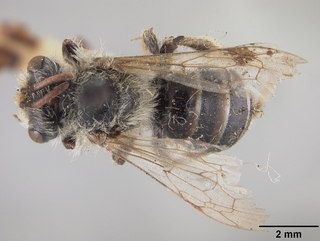
Smithsonian Institution, Entomology Department · 1
Andrena berkeleyi, face |

Click on map for details about points.
|
80x5 -
240x3 -
240x4 -
320x1 -
320x2 -
320x3 -
640x1 -
640x2
Set display option above.
Click on
images to enlarge. |

Smithsonian Institution, Entomology Department · 1
Andrena berkeleyi, side |

Smithsonian Institution, Entomology Department · 1
Andrena berkeleyi, top |
|
Overview |
Reprinted with permission of the University of Nebraska State Museum from:
LaBerge, W. E. 1967. A revision of the bees of the genus Andrena of the Western Hemisphere. Part I. Callandrena (Hymenoptera: Andrenidae). Bulletin of the University of Nebraska State Museum 7: 1-316.
Please report text errors to: leah at discoverlife dot org.
This colorful species is closely related to A. gardineri Cockerell. The female of berkeleyi differs from that of gardineri by the broad middle basitarsus, the usually red abdomen, the lack of a first tergal apical pale band and the higher vertex. The male of berkeleyi can be distinguished from that of gardineri by the slightly higher vertex, the larger yellow parocular maculae, the shinier mesoscutum and the short apical sternal fimbriae. The females associated here with berkeleyi were not collected with any of the know males. However, the structural correspondence seem to make probable the correctness of tins association.
FEMALE. MEASUREMENTS AND RATIOS. — N=4; length, 10-13 mm; width, 3.5-4.0 mm; wing length, M = 4.02 ± 0.196 mm; FL/FW, M = 0.97 ± 0.007; FOVL/FOVW, M = 2.44 ± 0.108.
INTEGUMENTAL COLOR. — Black except as follows: mandible except tip and clypeus dark rufescent; flagellum dark reddish-brown below; tegulae translucent reddish-brown to testaceous; wing membranes (hyaline, slightly infumate apically, veins brown; terga entirely orange-red except hyaline apices and tergum 2 with small lateral dark spots (3 specimens) to piceous with broad hyaline apices (1 specimen); sterna entirely orange-red with hyaline apices (3 specimens) to piceous (slightly rufescent basally) with hyaline apices (1 specimen); distitarsi rufescent; hind basitarsi and basal two-thirds of tibiae occasionally rufescent; tibial spurs testaceous.
STRUCTURE; Antennae as in gardineri. Eye more than four times as long as broad, inner margins parallel. Malar space, mandible and galea as in gardineri. Maxillary palpus as in gardineri but segmental ratio about 1.1:1.0:0.6:0.5:0.5:0.6. Labial palpus as in gardineri but segmental ratio about 1.6:1.0:0.5:0.6. Labral process as in gardineri. Clypeus protruding beyond lower ends of eyes by less than one-third its median length; evenly rounded from side to side with deep round punctures separated mostly by less than one puncture width, slightly sparser medially; surface shiny, shagreened only posteriorly, apical margin short medially. Supraclypeal area with crowded minute punctures, surface moderately shiny. Genal area as in gardineri but surface shinier especially posteriorly. Vertex above lateral ocellus equals almost one and one-half ocellar diameters; sculptured as in gardineri but shiny, shagreening sparse, delicate. Face above antennal fossae with coarse, round, almost contiguous punctures, interpunctural ridges slightly shagreened. Facial fovea short, extends below to level of middle of antennal fossae, narrow, in upper half well separated from eye margin, separated from lateral ocellus by almost one ocellar diameter.
Thoracic form and sculpturing as in gardineri except as follows: mesoscutal and scutellar punctures slightly coarser, surfaces shiny, unshagreened except at extreme periphery; propodeal dorsal enclosure finely rugulose as in western specimens of gardineri; mesepisternal punctures shallow, less distinct. Tegulae normal, impunctate. Wing venation as in gardineri but middle submarginal cell narrower anteriorly than posteriorly and slightly longer than one-third of first cell. Claws and tibial spurs normal.
Metasomal sculpturing as in gardineri but punctures slightly coarser and more crowded especially on terga 1 and 2 and sterna unshagreened or delicately so. Pygidial plate with broadly rounded apex.
VESTITURE. — White to pale ochraceous, vertex and thoracic dorsum slightly darker, Tergum 1 lacking apical pale fascia. Terga 2-4 with apical pale fasciae interrupted medially, broadly so on 2 and 3 and narrowly on 4. Leg hairs and pollen-collecting hairs as in gardineri but middle and hind basitarsi with outer surfaces and scopal hairs extremely pale fuscous in two specimens (ochraceous in the other two). 1
MALE. MEASUREMENTS AND RATIOS. — N = 2; length, about 11 mm; width, about 2.5 mm; wing length, 3.58-3.96 mm; FL/FW, about, 1.02; FS1/FS2, 2.50-2.82. l (
INTEGUMENTAL COLOR. — As in gardineri except as follows: clypeus yellow at extreme lateral angles as well as elsewhere; parocular area with large yellow macula; tegula piceous to translucent reddish-brown; wing membranes slightly infumate apically, veins dark brown; hind basitarsi piceous.
STRUCTURE; Antennae as in gardineri but scape length about equal to flagellar segments 1-3. Eye as in gardineri. Malar space, mandible and galea as in female but mandible lacking basoventral lamella and subgenal coronet. Maxillary palpus as in female but segmental ratio about 1.0:1.0:0.5:0.6:0.6:0.7. Labial palpus as in female but segmental ratio about 1.6:1.0:0.5:0.6. Labral process as in gardineri. Clypeus as in female but punctures slightly smaller. Supraclypeal area with minute punctures and delicate shagreening moderately dulling surface. Genal area, vertex and face above antennal fossae as in female. Vestige of facial fovea (present in gardineri) absent.
Thoracic sculpturing as in female except as follows: propodeal dorsal enclosure slightly more coarsely rugulose; mesepisternal punctures more distinct. Wing venation as in female. Claws and tibial spurs normal. Metasomal terga as in female but tergum 1 with punctures more crowded, separated by less than one puncture width and terga 2-5 with basal area punctures separated mostly by half a puncture width or less. Pseudopygidial area not evident. Sterna 2-5 sculptured as in female. Sternum 6 with apicolateral angles reflexed strongly, forming large teeth, medially scarcely reflexed.
Genitalia and sterna 7 and 8 (Figs. 287-291) as figured; compare with those of balsamorhizae.
VESTITURE. — Generally white, cinereous or pale ochraceous on vertex and thoracic dorsum. Terga 1-5 with narrow, white, distal fasciae, those of terga 1-3 weak or interrupted medially. Sterna 2-5 with short white apical fimbriae of barbed hairs, fimbriae considerably shorter than in gardineri. Inner surfaces tarsi pale yellow.
TYPE MATERIAL. — The holotype male, (USNM No. 18,136) was collected at Berkeley, Colorado.
DISTRIBUTION. — A. berkeleyi is known from Colorado, Oklahoma (and Texas. Only six specimens, in addition to the holotype, have been examined. The data for these are given in full.
OKLAHOMA: Caddo. 1 female, April 10, 1953, the University of Kansas Mexican Expedition. Mt. Scott. 1 female, May 30, 1931, H. Mathewson. TEXAS: Eagle Pass. 1 female, March 28, 1940, C. D. Michener. Eldorado. 2 males on Englemannia pinnatifida, April 10, 1950, C. D. Michener, R. H. Beamer, G. Rozen and W. P. Stephen. Fabens. 1 female on Actinea sp., April 22, 1954, L. D. Beamer.
|
|
|
Names | |
|
|
|
References | |
Andrena berkeleyi Viereck and Cockerell, 1914, Proc. United States Nat. Mus., vol. 48, p. 19.
|
|
| Supported by | |
Updated: 2024-04-24 08:41:26 gmt
|